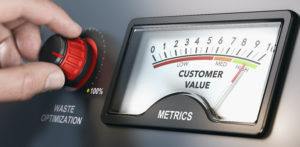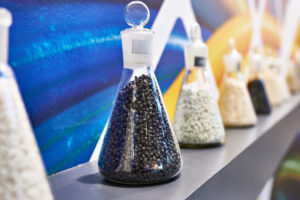
Have you ever shaken a ketchup bottle because the ketchup was stuck? Industrial vibrators work the same way. The movement breaks apart the material and loosens it from the vessel walls.
But as you’ve probably noticed, there will always be a little bit of ketchup left in the bottle. Vibration can never completely flush a vessel completely clean, especially if the material is damp or dense.
In some cases, industrial vibrators can actually make the material more compact, which is why it is sometimes used to compress materials before packaging. But as a material flow aid, it has limited capability and a lot of trade-offs—such as the need to manually clean material residue, or repair vessels because of metal fatigue.
That’s why many companies who tried industrial vibrators looked for a more effective solution, and found it in AirSweep.
Food Industry
To prevent spoilage, food manufacturers need to achieve first in/first out, on-demand flow. Any stagnant material can degrade and contaminate an entire batch.
The food industry also works with materials with problematic flow properties which don’t respond well to vibration.
Dense, Sticky Materials
Ingredients with a high-fat content will stick to vessel walls, and form a dense bridge or arch that cuts off the flow of material.
A cheese company had similar issues with protein concentrate (WPC). Vibrators only packed the sticky material and worsened the problem. Unfortunately, the stagnant material sparked a fire in their baghouses, creating an urgent safety concern.
They switched to the USDA-accepted AirSweep system. The powerful air pulses sliced through the blocks just like an “air knife”, leaving no residue that could compromise both plant safety and product quality. They now use AirSweep in all their plants in the United States.
Fine Powders
A candy manufacturer processes hundreds of pounds of cocoa a day. However, production would stall because the fine powder would pack, bridge and rathole in the hoppers. They tried vibrators, fluidizers and bin aerators—all of which failed. Workers still had to scrape the vessels every 3 days.
But when they switched to AirSweep, success was sweet. “AirSweep works,” said the coatings manager. “We had no breakdowns, replacements or problems whatsoever.” AirSweep also used less plant air and had lower maintenance costs, leading to savings that recovered the system’s cost after two months.
High Moisture Content
A pet food company used a meat, vegetable and grain mixture with a high moisture content. They tried vibrators and pneumatic hammers, but workers still had to climb two stories of stairs to manually clear the bins.
With AirSweep, they were able to achieve on-demand flow. They even use the system to clear out kibble fines as part of the automated clean-outs.

Chemicals
Chemical compounds are used in many industries, such as the dyes and pigments in paints and ceramics, the anti-bacterials in household cleaners, the emulsifiers in food, or the catalyzing agents in pharmaceuticals, and the polymers and plastics in manufacturing.
However, chemicals can have challenging flow properties, and they can react to the environment or with other materials in the process.
Clumping
An aviation company that deices gates, ramps and other airport equipment had issues of their formula forming rock-solid clumps. The company’s process engineer suggested vibrators. But after the maintenance supervisor saw its description of “gentle vibration,” he knew it wouldn’t work.
When they saw how AirSweep worked, they knew they had found the right flow aid. “AirSweep has made a 100% difference to our materials flowing,” he said.
Bridging
A global manufacturer of carbon black additives suppliers over 2 million tons to paint, plastic, rubber, tire and ink industries every year. However, carbon blank has a tendency to form deposits on conveyors, cake while unloading, and bridge in the hoppers.
When vibrators proved ineffective, they switched to AirSweep. Installation took less than 48 hours, and since then, they never had to worry about process delays.
Cement Industry
Cement uses some of the most challenging bulk materials, including fine or moist limestone, slag, clay and bauxite. The cohesive and adhesive properties that make them so ideal for construction also create issues like bridging, ratholing, and flooding.
AirSweep is used in the factories of some of the biggest cement manufacturers in Asia and North America.
A regional manufacturer of asphalt had been using electric vibrators for years. But over the weekend, the asphalt would settle, forcing workers to spend most of Monday clearing out thick layers of compact material.
Once they switched to AirSweep, they never had this problem again. “After four years, we finally have the right solution! We are very happy with the system,” said the plant manager.
AirSweep also helped a cement company in Asia dramatically improve production. Cement materials would solidify because of plant humidity, forcing long plant shutdowns and a loss of $12,000 per hour of downtime.
They had tried vibrators and air knockers, but only AirSweep was able to create on-demand flow—while using half as much energy as other flow aids.
AirSweep is More Effective than Vibrators
Flow tests and case studies have shown that AirSweep is more powerful and cost-efficient than vibrators and other flow aids that use agitation. For more comparisons of AirSweep vs Vibrators, check out these links:
- Video: AirSweep vs Vibrators – Performance, Costs, and ROI
- Competitive Analysis: Industrial Vibrators Pros and Cons
- Brochure: Vibrators vs AirSweep





Comments are closed